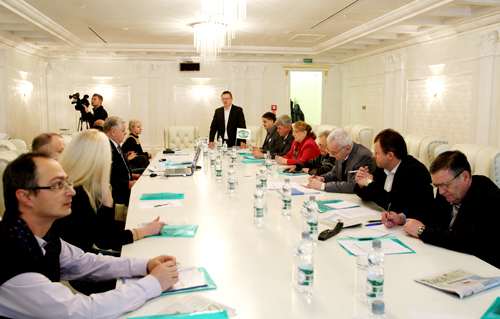Ru
|
Eng
NGOs from Lithuania, Russia to monitor environmental impact of Belarus’ NPP
05.11.2013

Environmental organizations from Lithuania and Russia have joined the public monitoring of the environmental impact of the Belarusians nuclear power plant. The Belarusian public association Environmental Initiative concluded a cooperation agreement with two foreign NGOs – the Institute for Regional Development and Democracy (Lithuania) and the Interregional Public Environmental Movement Oka (Russia) during a roundtable session to present the project “Public monitoring of the environmental impact of the Belarusian NPP”, BelTA has learnt.
The participants of the roundtable session noted that the concluded agreements envisage an active participation of the Lithuanian and Russian NGOs in the project. In particular, the partner organizations will share best practices in environmental monitoring of nuclear energy installations and carry out joint examination of the radiation level near the nuclear power plant in Ostrovets.
According to head of the Environmental Initiative organization Yuri Solovyov, the IAEA and other reputable organizations admitted that the design of the Belarusian NPP developed by the Russian company Atomenergoproekt is among the world’s safest. “Therefore, one of our major objectives today is to conduct the public monitoring of the construction of the Belarusian nuclear power plant and to implement all the safety measures stipulated by the design estimates,” he emphasized.
The participation of foreign environmentalists in the public monitoring brings this process onto the international level. It will help ensure an independent public control over the environmental impact of the Belarusian NPP, Yuri Solovyov said.
“Besides, the cooperation with international non-governmental organizations in this field confirms that in Belarus the public is able to get the necessary information about the measures to ensure environmental safety during construction and operation of nuclear energy facilities,” he said.
On 14-18 October volunteers of not-for-profit organizations together with specialists of the National Center for Radiation Control and Environmental Monitoring of the Ministry of Natural Resources and Environmental Protection tested soil, air and water in the area of the Ostrovets NPP.
They selected and tested the soil and air samples for Caesium-137 and Strontium-90 and measured gamma-radiation in Ostrovets and the villages of Gozy and Trokeniki, Ostrovets District, and on the NPP construction site.
The information about the results of the public monitoring will be available by mid-November, will be distributed using mass media and discussed at roundtable sessions and seminars that are to be held during the project implementation in Belarus, Lithuania and Russia.
The data that will be obtained during the tests will allow exercising public control over the environmental safety of the NPP and will become the basis for an independent monitoring of the impact of the nuclear power plant on the environment and human health.
The participants of the roundtable session noted that the concluded agreements envisage an active participation of the Lithuanian and Russian NGOs in the project. In particular, the partner organizations will share best practices in environmental monitoring of nuclear energy installations and carry out joint examination of the radiation level near the nuclear power plant in Ostrovets.
According to head of the Environmental Initiative organization Yuri Solovyov, the IAEA and other reputable organizations admitted that the design of the Belarusian NPP developed by the Russian company Atomenergoproekt is among the world’s safest. “Therefore, one of our major objectives today is to conduct the public monitoring of the construction of the Belarusian nuclear power plant and to implement all the safety measures stipulated by the design estimates,” he emphasized.
The participation of foreign environmentalists in the public monitoring brings this process onto the international level. It will help ensure an independent public control over the environmental impact of the Belarusian NPP, Yuri Solovyov said.
“Besides, the cooperation with international non-governmental organizations in this field confirms that in Belarus the public is able to get the necessary information about the measures to ensure environmental safety during construction and operation of nuclear energy facilities,” he said.
On 14-18 October volunteers of not-for-profit organizations together with specialists of the National Center for Radiation Control and Environmental Monitoring of the Ministry of Natural Resources and Environmental Protection tested soil, air and water in the area of the Ostrovets NPP.
They selected and tested the soil and air samples for Caesium-137 and Strontium-90 and measured gamma-radiation in Ostrovets and the villages of Gozy and Trokeniki, Ostrovets District, and on the NPP construction site.
The information about the results of the public monitoring will be available by mid-November, will be distributed using mass media and discussed at roundtable sessions and seminars that are to be held during the project implementation in Belarus, Lithuania and Russia.
The data that will be obtained during the tests will allow exercising public control over the environmental safety of the NPP and will become the basis for an independent monitoring of the impact of the nuclear power plant on the environment and human health.
BELNPP: NEWS FROM CONSTRUCTION SITE
23.07.2024
11.07.2024
28.06.2024
06.06.2024
04.06.2024
04.06.2024
03.06.2024
24.05.2024
23.05.2024
03.05.2024













